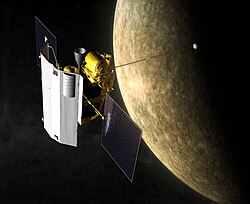


This is a list of uncrewed spacecraft which have been intentionally destroyed at their objects of study, typically by hard landings or crash landings at the end of their respective missions and/or functionality. This list only includes spacecraft specifically instructed to crash into the surface of an astronomical body other than the Earth, and also does not include unintentionally crashed spacecraft, derelict spacecraft, or spacecraft designed as landers. Intentionally crashing spacecraft not only removes the possibility of orbital space debris and planetary contamination, but also provides the opportunity (in some cases) for terminal science given that the transient light released by the kinetic energy may be available for spectroscopy; the physical ejecta can be used for further study.
Contents
- Planets
- Mercury
- Venus
- Mars
- Jupiter
- Saturn
- Planetary moons
- Earth's Moon
- Other bodies
- Asteroids
- Comets
- Chronological gallery
- See also
- References
Even after soft landings had been mastered, NASA used crash landings to test whether Moon craters contained ice by crashing space probes into craters and testing the debris that got thrown out. [1] Several rocket stages utilized during the Apollo space program were intentionally crashed on the Moon to aid seismic research, and four of the ascent stages of Apollo Lunar Modules were intentionally crashed onto the Moon after they had fulfilled their primary mission. In total at least 47 NASA rocket bodies have impacted the Moon.
A recent impactor, the unusual double-crater of which was photographed on March 4, 2022, by the Lunar Reconnaissance Orbiter, is of unknown provenance; no space program has taken credit for it, [2] although a later study attributed it to a spent upper stage from the Chang'e 5-T1 mission. [3]
The Deep Impact mission had its own purpose-built impactor which hit Comet 9P/Tempel 1. Terminal approaches to gas giants which resulted in the destruction of the space probe count as crash landings for the purposes of this article. The crash landing sites themselves are of interest to space archeology.
Luna 1, not itself a lunar orbiter, was the first spacecraft designed as an impactor. It failed to hit the Moon in 1959, however, thus inadvertently becoming the first man-made object to leave geocentric orbit and enter a heliocentric orbit, where it remains.

















